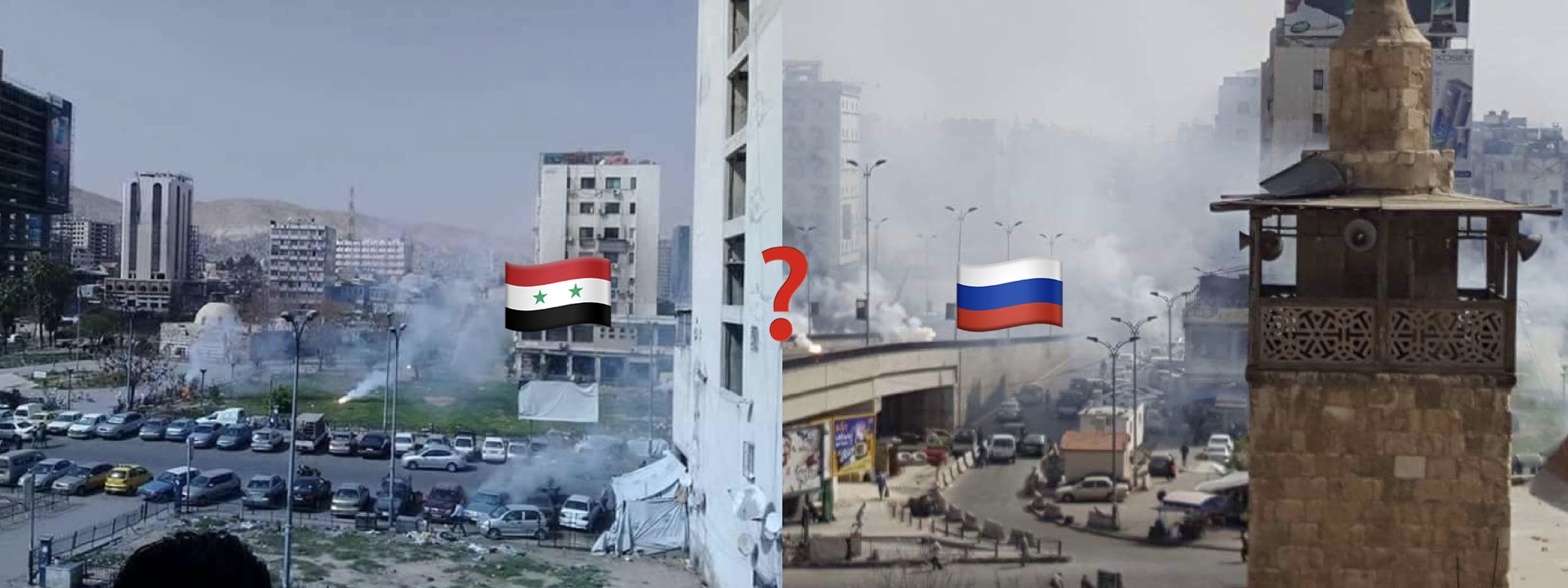#PutinAtWar: Russia Bombs Damascus?
Investigating an alleged Russian incendiary attack on Damascus
#PutinAtWar: Russia Bombs Damascus?

Investigating an alleged Russian incendiary attack on Damascus

The ongoing conflict in Syria took an unusual turn. On March 22, citizens in areas of Damascus controlled by Bashar Al-Assad’s regime witnessed what civilians in Eastern Ghouta, Afrin, Idlib and many other rebel-held Syria cities witnessed numerous times during the conflict — an incendiary attack. The claims of incendiary attack on government-held territory were unusual, since there have not been reports of rebels possessing or using incendiary munitions in Syria before. @DFRLab examined the open source evidence to check the veracity of the claims.
The videos of the alleged bombing surfaced on March 22. A variety of videos and photos taken by civilians appeared on social media and provided a chance to geolocate the incident.
https://twitter.com/anteebah_alSham/status/976825686085292032
The first geolacated area appeared to be Al Thawra street, near the Aramani Garden. At least three components of incendiary munitions can be seen burning on the Al Thawra street.

Another burning munition recorded on the video was geolocated in the Armani Garden itself. A close-up of the burning object looks very similar to a bomb of incendiary nature.

Another geolocated area in the video was Al Marjeh square. The Yalbogha Mosque and the Telecommunication monument served as clear landmarks for geolocation. At least two incendiary bombs were seen burning near hotel Samarkand, another two were seen near the Armani Garden.

Additional photos uploaded by civilians showed the aftermath of the incendiary attack. Judging by the photos, the aforementioned munitions look like incendiary weapons. The white burn marks on the concrete suggest that the munitions could be white phosphorus bombs, as numerous allegations of Russia use of that weapon have surfaced before.
Nonetheless, it was impossible to conclusively identify the weapons using only the open source data. The photos of the aftermath in Damascus did not possess enough details or landmarks for geolocation. It was also impossible to be certain whether incendiary bombs or rockets were used in this attack, because the moments before impact were not recorded.

A visual comparison between incendiary weapons employed previously at Ltaminah and the recent incident in Damascus suggested that the weapons were similar in nature. Furthermore, Russian aircraft in Syria were spotted carrying RBK-500 ZAB.5SM incendiary munitions last year. Signs of likely Russian use of incendiary weapons were also reported by @DFRLab earlier this year.

The location of the al Thawra street was in eastern part of Damascus, at least three kilometers away from the closest rebel held territory. This location raised a lot of questions, since there were no reported instances of rebel forces possessing such weapons. Furthermore, in case of incendiary bombs, rebels would have had to possess working aircraft, which has not been the case throughout the conflict.
The only two possible options of forces capable of incendiary attacks in the region are Assad’s forces and Russia. It is hard to believe that Damascus, as the capital of Assad’s Syria, would have been intentionally targeted by Assad, although he has proven track record of not hesitating to carry out attacks on Syrian civilians. Basic miscalculation is a possible option.
Judging by the recent history of incendiary weapons use in Syria and recorded incendiary weapons stored at Khmeimim Air base, it is highly likely that the attack was carried out by Russia. The motives are currently unclear, ranging from calculation error to false-flag operation. Also, the borders between territory held by the rebels, as opposed to the regime, might be difficult to distinguish from air because of the urbanized area.

Here are the locations pinpointed on the map:
Conclusion
Incendiary weapons in Syria became a sad reality years ago, nonetheless, this was the first recorded incendiary weapons attack on Damascus. The location of the bombing raised a lot of questions, since the rebels are not known to possess such weaponry or aircraft. Only Assad’s forces or Russia would be able to inflict such an attack, and judging by previous evidence of incendiary weapons activity, it was highly likely to be Russia. The motives of such operation remain unclear, possibly being an error of the pilots, or even a false-flag operation.
@DFRLab will continue to monitor Russian military activity in Syria and other developments in Eastern Ghouta region.
Follow along for more in-depth analysis from our #DigitalSherlocks.

